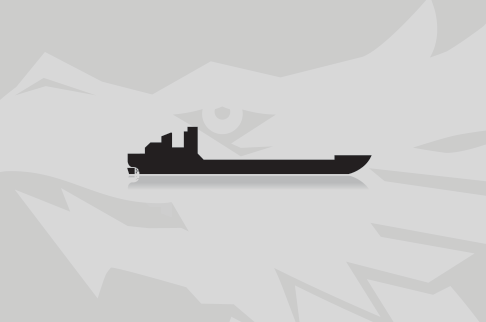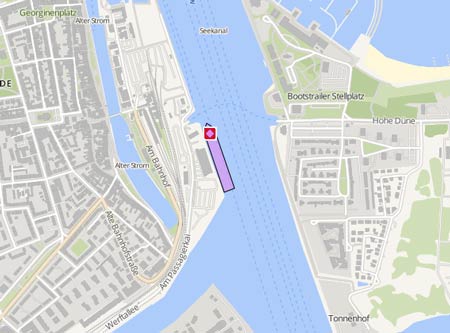REMY RHEX
Kurs/Position
vor < 1 Min
Die letzten Häfen
Die letzten Wegpunkte
Die neuesten Nachrichten
NTSB published report on crane accident
The National Transportation Safety Board (NTSB) has issued an investigation report regarding a crane accident on March 6, 2022, when the 'Robert Cenac' was transiting the Gulf Intracoastal Waterway, in Houma, Louisiana, pushing ahead the crane barge 'Mr. Dawg' and another deck barge. While passing the Houma Twin Span Bridges, the crane aboard the 'Mr. Dawg' allided with the eastbound span of the bridge. Eastbound automobile bridge traffic was reduced from two lanes to one for 10 days. No pollution or injuries were reported. Damage to the bridge was estimated at $1.5 to $2.0 million. Unbeknownst to Sealevel staff, who chartered the tow, their last crew to use the crane aboard the 'Mr. Dawg' did not lower the boom to an angle typically used for transport—with the boom lowered below the barge’s raised spud tops. Both the tug operator (Al Cenac Towing), shoreside staff and the tug crew were concerned about the height of the crane, and the captain observed that the head of the crane boom was higher than the crane barge spuds, contrary to what Sealevel had initially communicated to Al Cenac Towing. Despite being asked at least twice about the height of the crane by the towboat operator before departure, Sealevel staff did not provide Al Cenac Towing with a verified crane height. Without a verified crane boom height, the captain of the 'Robert Cenac' estimated the total air draft of the tow, assuming the spuds to be a standard 50 feet high and then estimating the portion of the crane boom above the spuds at 10 feet, arriving at a total air draft of about 60 feet. However, the raised spuds on the Mr. Dawg had an air draft of about 56 feet, not 50 feet as the captain assumed. The National Transportation Safety Board determined that the probable cause of contact of the 'Robert Cenac's tow with the Houma Twin Span Bridge was the tug captain’s incorrect estimate of the crane boom height and his decision to depart before getting a confirmed height from the chartering company. Contributing to the incident was the crane barge owner not providing the accurate air draft information to the tow company.
Report: Poor communication cited in barge accident
The National Transportation Safety Board (NTSB) cited poor communication as one of the causes of the allision of a barge, pushed by the 'Robert Cenac', with a railroad bridge on Louisiana’s Lake Borgne, near Lake Pontchartrain. The tug was pushing the 195' barge through an open railroad swing bridge. Offering a vertical clearance of 11' in its closed position, the 414' span could rotate to provide a 153'-wide passage to vessels. At around 10:30 p.m. on Jan. 12, 2021, the pilot radioed ahead at mile 38 to notify the bridge operator that they were roughly 30 minutes away and would require opening of the bridge span. The bridge operator responded that two trains had to pass first. Shortly after 11:00 p.m., the tug pilot observed the two trains pass. After seeing this, he asked the bridge operator if the bridge was open. When asked where he was, he replied that he was about 15 minutes away waiting for the bridge. The bridge operator replied that he was going to open the bridge. At some point after 11:30 p.m., the captain relieved the pilot. They worked on a six-on, six-off schedule. Shortly before midnight, the tug and barge commenced their transit of the passage at around seven mph, and the port side of the barge struck the south end of the overhanging bridge span. According to the NTSB, the bridge was not fully open. The NTSB cites communication deficiencies of the towboat in failing to confirm the bridge was fully open, and those of the bridge operator for failing to notify the towboat if he observed that the bridge was not fully open. Absence of bridge span lighting contributed to the accident.
NTSB Report: Poor communication led to allision in Louisiana
On Jan 12, 2021, the 'Robert Cenac' pushed ia barge into the CSX railway swing bridge that crosses the Rigolets near Slidell. The impact caused an estimated $1.1 million in damage to the bridge, which dwarfed the $5,000 in damage the barge incurred. After conducting its investigation into the incident, the National Transportation Safety Board (NTSB) concluded that poor communication between the captain and the bridge operator likely led to the allision. The NTSB also noted the swinging span of the bridge lacked navigation lights, making it more difficult for vessel operators to visually confirm its status. The tug was pushing a hopper barge en route from Heron Bay, heading west along the coast, through the CSX railroad bridge, then back east to the Pearl River and up to Port Bienville. At about 10:30 p.m., the pilot aboard the 'Robert Cenac' radioed the bridge operator to say the vessel was about 30 minutes away. The bridge operator indicated that there were two trains on approach that needed to pass before the bridge could be opened. With that information, the pilot slowed his approach and, around 10:53 p.m., brought the engines to idle about 2.4 miles from the bridge. By about 11:06 p.m., the 'Robert Cenac' had closed the distance to about 1.5 miles. While holding the vessel steady in the channel, the pilot saw both trains cross the bridge. Records indicate the bridge circuit changed from “occupied” to “unoccupied” at 11:34 p.m., indicating the second train had cleared the bridge. Shortly after 11:30 p.m. the captain came on watch, relieving the pilot, who radioed the bridge again as his watch was coming to a close. The pilot told investigators the bridge operator replied with “Cap, where are you at?” The pilot replied, “I’m sitting here waiting on you, about 15 minutes away.” The pilot told investigators the bridge operator replied with “I’m gonna get it open for you, cap.” The pilot left the wheelhouse at 11:45 p.m. The captain told investigators he received a call “at some point” from the bridge operator, stating the bridge was open. Electronic chart data from the vessel indicated it started moving toward the bridge at 11:48 p.m. Anticipating an east-to-west current, the captain lined up “a little to the east.” About a quarter of a mile away, the captain used the vessel’s spotlight to spot the bridge fenders. About 2,000 feet from the span and closing, the captain said he “saw the swing span was not fully open as he said he had been informed and was overhanging the long fender ‘looking as if it was three-quarters of the way open.’” The captain said that, by the time he noticed the bridge wasn’t completely open, it was too late to stop his forward momentum. Records indicated the tow was moving at 7.1 mph at 11:58 p.m. Less than a minute later, its speed began to decrease rapidly. The bridge operator told investigators he saw the 'Robert Cenac' closing in on the span “while his hand was on the lever opening the bridge.” When the pilot, now in the galley, felt the impact, he returned to the wheelhouse in time to see the barge move away from the swing span, which finished opening. The bridge operator said over the radio, “Alright, cap, the bridge is full open,” which made the pilot think the bridge operator was unaware of the allision. The captain replied, “Yeah, I hit the bridge.” During the investigation, the bridge operator said he told the tug crew he was “starting to operate the bridge and that he would let them know when it was fully open and clear to come through.” The bridge operator said, when the captain said he’d hit the bridge, that he replied, “I was still operating the bridge and it wasn’t fully open and I didn’t clear you to come through yet.” The bridge operator then said he heard the captain indicate a crew member on the barge had said the bridge was open, which led him to go through the bridge. The captain stopped the vessel alongside the bridge’s long fender and called his company and the Coast Guard. Likewise, the bridge operator called CSX personnel, who stopped approaching rail traffic. The 'Robert Cenac' got underway shortly after 1:30 a.m. The bridge operator attempted to close the swing span, but it would not close completely. The bridge reopened to full service on March 2, 2021.
News schreiben


